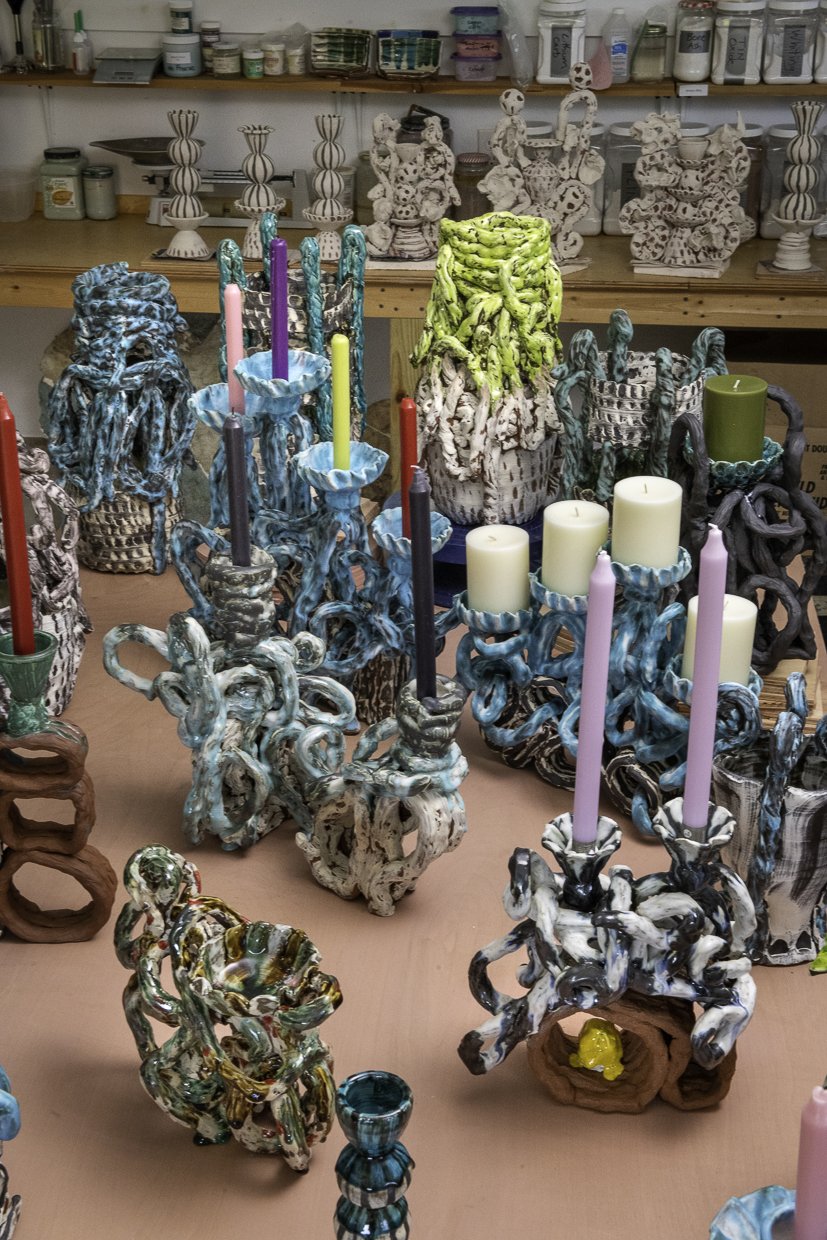Writing
photo credit: Brian Oglesbee
The candelabra grins madly, leaping and twirling about the room, flames aflicker. “Be our guest!,” it sings, “be our guest, put our magic to the test!,” silver, plates, a shelf clock and various other accoutrements put on a fine show. The scene is, of course, from Disney’s much-loved movie The Beauty and the Beast. Futuristic when it first appeared, thanks to its use of then-new digital technology, the film is now comfortably wrapped in nostalgia, though it’s not nearly as historic as the objects that helped to inspire the scene, as well as Disney’s earlier work. That whole long overlapping history was the subject of the exhibition Inspiring Walt Disney: The Animation of French Decorative Arts, held at the Metropolitan Museum of Art. It was a massive hit, but there can’t have been anyone who responded to it more creatively than Graham Marks. His new body of work, shown at Sculpture Space NYC - Center for Ceramic Art, had its initial spark at the Met, and from there, he’s taken the basic idea of an animated thing and run with it – and leapt and twirled, too. Predominantly coil-built, these objects exemplify the adage (attributed to Paul Klee) of “taking a line for a walk.” They swarm with sinuous elements which defy any easy categorization. Are they primary structure? Applied handles? Simply decoration? They’re sufficiently splendid that it doesn’t much matter, all the more so given their luscious polychrome glazes, in a palette that recalls both Bernard Palissy, the 17th century French potter, and Marks’ great contemporary Annabeth Rosen.
All this exuberance will come as a bit of a shock to anyone who knows Marks as a ceramicist – a profession that he pursued up until three decades ago, when he had a career change and became an acupuncturist. Now he’s back, and it is not altogether surprising that he has returned to the medium with fresh eyes. His earlier works were also coil-built, admittedly, but also monumental in scale, rigorously structured, and largely unglazed, so as to expose the color and texture of the clay. Marks’s sudden attraction to the baroque and rococo has caught even him off guard: “In art school in the early 1970’s, this was material I never looked at. It was seen as kind of frivolous, decadent, of the past.” A lot has happened since then, though: postmodernism, a tendency toward “sloppy craft,” an unprecedented embrace of ceramics within the mainstream art world. Marks’ new direction is not contained by any of these phenomena, but it is a vector that can be mapped in relation. (Also relevant: more remote sources, like Jomon ware from ancient Japan and ancient alabaster carvings from Egypt). In any case, this recent work is much more than the sum of its many parts. It conveys the sheer joy of an artist’s reunion with medium, and the formal intelligence that comes from a lifetime of looking. Most of all, it is free – free of his own past, free of any particular expectation about what might come next, free of anything that doesn’t feel good right now. Marks is putting his own personal magic to the test – and he’s passing with flying colors.
Glenn Adamson, independent curator, author, and historian
It can bE what it becomes
SCULPTURE SPACE NYC
NOVEMBER 4 - DECEMBER 3, 2022
photo credit: Brian Oglesbee
I started working in clay in 1967 and went on to have a professional career teaching and making large, coil-built ceramic sculpture based on ideas about the vessel and nature.
In 1992 I followed an interest in healing and went back to school to become an acupuncturist. After graduation, I maintained a rural private practice for twenty-five years.
This show marks my return to ceramics after a thirty-year hiatus. There is one important lesson that I brought with me to this new work. As an acupuncturist, I often would have what I thought was the best treatment plan for a patient… but it was only a preconception. When an individual walked through the door, I had to respond to who that person was and to what they needed in that present moment. To be sensitive to the energy, I had to let go of preconceived notions.
Now, back in the studio, in my 70’s, I strive to remember that lesson, and to listen and shift in response to what the material asks for. The ideal is to improvise and stay out of my own way. I want the process to be joyful and the coils used in construction to be dynamic, playful, and liberated. I chose vases and candelabras because they are opened-ended formats and have celebratory roles in our lives.
I want to thank Sculpture Space NYC – The Center for Ceramic Arts for their support and encouragement and for creating such a perfect environment for ceramic artists. And to Glenn Adamson for his insight and enthusiasm. Also, thanks to Northern Lights Candles of Wellsville, New York for their generous support and Brian Oglesbee for his great eye.
Graham Marks
Graham Marks has taught ceramics at Kansas State University, Rochester Institute of Technology, and from 1986-1992 was Head of Ceramics at the Cranbrook Academy of Art. His work has been exhibited internationally and collected privately and by numerous public institutions including Yale University Art Gallery, Detroit Institute of Art, The Everson Museum Syracuse NY, Museum of Art and Design NYC, Cranbrook Museum of Art, Bloomfield Hills, MI, Stedelijk Museum, ‘s’Hertogenbosch the Netherlands, The State Hermitage Museum, St. Petersburg, Russia, and The National Gallery of Australia, Canberra. Graham splits his time between Brooklyn and Alfred, New York.

